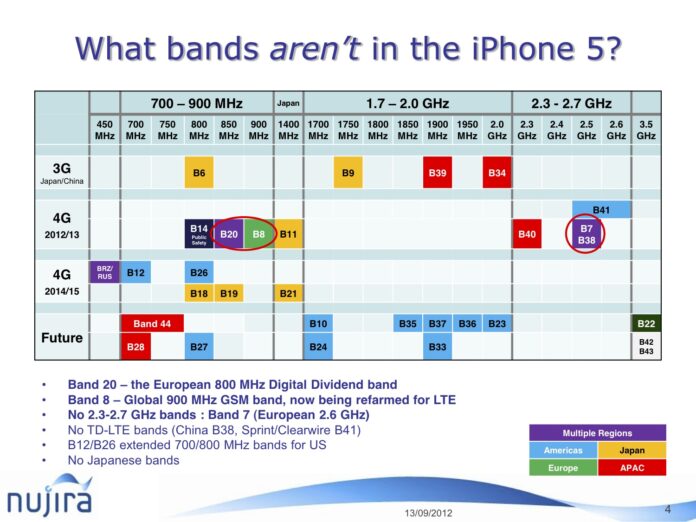The iPhone 5 has, as you will probably know, been released in three flavours of spectrum support. You might be wondering why device manufacturers don't just fling in a whole load of RF front ends to cover all possible combinations. The answer, of course, is power and space. Here, Nujira's CMO Jeremy Hendy takes a look at the iPhone 5's likely internal RF (Radio Frequency) and PA (power amplifier) structure, and gives a good explanation as to the decisions a designer like Apple faces when it decides which spectrum bands to include. Nujira is a developer of the "envelope tracking" technology Hendy mentions.
Hendy writes:
The need to simultaneously support different systems (LTE, WCDMA, HSPA, MC-GSM etc.) in one handset, while simultaneously supporting an increasing number of frequency bands (LTE will be available in 18 bands by the end of 2012), has resulted in a significant increase in RF system complexity for mobile handsets.
The traditional approach to these challenges has been to use a number of separate PAs (maybe up to 8 in current 3G designs) within the handset RF subsystem, each covering a fairly narrow band, and optimised for peak efficiency for that band and the system being supported. This works well when only a few frequency bands are required, but quickly becomes very complex for multiband, multimode handsets designed to support LTE, with RF switching and thermal issues all making a compact, cost-effective solution extremely difficult to achieve.
Moreover the power efficiency of broadband PAs designed to cover broader frequency ranges also makes them currently unviable for commercial deployment in a device like the iPhone 5. Whereas narrowband PAs may achieve something in the region of 30-35% efficiency, a current broadband PA is 5-10% down on efficiency.
So whether using narrowband or broadband PAs the greater demands to support multiple transmission modes and frequency bands being placed on cellular radios in LTE handsets force designers to devote more space and power consumption to the RF system.
As a result it is currently extremely difficult to design in support for all LTE bands without having a dramatic effect on the cost and physical size of handsets or their battery life (early LTE handset battery life is already measured in mere hours rather than days).
So Apple have been forced to adopt three separate product SKUs for different regions/operators for the iPhone 5:
- US AT&T
- US Verizon
- Rest of World
The phone is likely to use a “world phone” configuration for 2G and 3G, plus a couple of narrowband “bolt on” LTE PAs which are band/region specific; these could either be PA-Duplexer modules, or separate PAs & Duplex filters.
Each of these lineups has to be highly tuned today, and adds to the phone footprint and cost, due to the PA & the duplex filter. That is why we don’t see any single product covering all the LTE bands yet. It looks like 2 or 3 region-specific PAs and filters.
There are several bands that the iPhone 5 notably *doesn’t* support – if we exclude Japan and China from the equation, the big missing capabilities are:
- Band 20, the European 800 MHz digital dividend band
- Band 7, the European 2.6 GHz LTE band already deployed across Europe, Brazil, Russia and parts of Asia
- Bands 38 and 41, the 2.5/2.6 GHz TD-LTE bands being deployed by China Mobile and Clearwire/Sprint in the US
It’s unclear why the phone doesn’t support LTE in Band 8 (900 MHz), since it can already do 3G in that band. Maybe the Band 8 PA isn’t capable of reaching the LTE peak output power requirements (which are twice those of 3G). We’ll have to wait for the teardown to see.
Band 20 could almost certainly have been accommodated in the “rest of world” SKU by taking the AT&T model, and swapping out the Band 13 PA/filter lineup for the Band 20 PA/filter lineup.
The 2.3-2.7 GHz bands are a bigger challenge – RF layout, switch/filter losses, and antenna design all contribute to making these significantly harder to engineer within the phone. It may also make sense to create a design for the 2.3-2.7 bands which covers both FDD band 7 and TDD bands 38, 40 and 41 for China & the US.
A version which “bolts on” bands 7 (2.6 GHz) and 20 (800 MHz) would definitely make sense as an later product – perhaps in the “5S”?.
For iPhone 6, we would expect to see adoption of a multimode/multiband solution that removes many of these limitations, using Envelope Tracking technology to recover the efficiency which is lost when moving from narrowband to broadband PAs.
Most LTE smartphones support all “world bands” for 2G and 3G – Bands 1, 2, 3, 4, 5 and 8. The RF front ends for these bands are relatively mature, and have been integrated to some extent. Barclays Research predicted a few months back that the iPhone 5 would have two dual-band 3G PA/duplexer modules covering 1+8 and 2+5, plus three bolt-on LTE PAs for bands 4, 13 and 17.
Quad band GSM is generally integrated into a single PA module. Due to the higher power level requirements for GSM signals, these are generally handled by a completely separate transmit chain, even though the frequency bands are often the same between 2G and 3G. Although “Hybrid” multimode multiband PAs are starting to appear, which integrate GSM functionality into a single package, these are multi-chip modules which still maintain a separate GSM transmit chain. True “Converged” multimode, multiband PAs (which use the same chain for 2G and 3G) are starting to appear but it’s a difficult design compromise to accommodate the high power of GSM with the high linearity of 4G.
LTE requires around twice the peak power output from the RF power amplifier – this is very hard to achieve with today’s 3G PAs unless you use a technology like Envelope Tracking.




